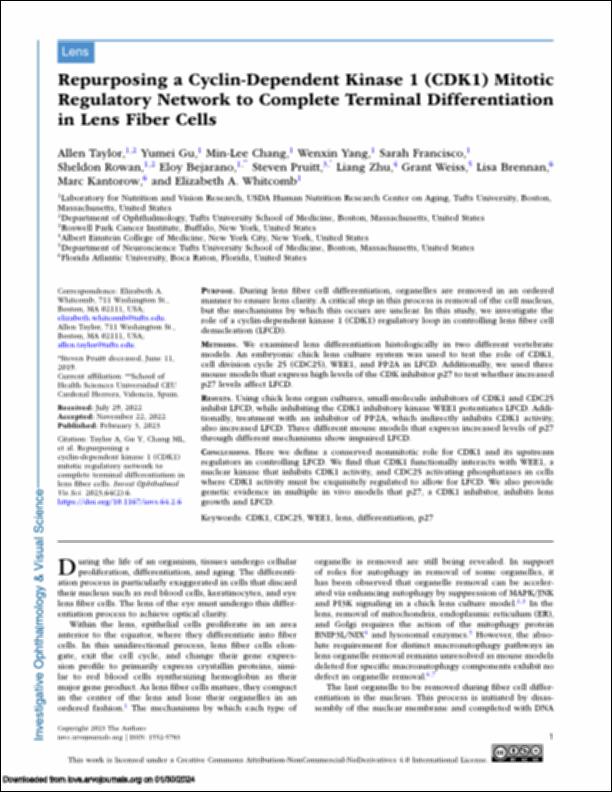Por favor, use este identificador para citar o enlazar este ítem:
http://hdl.handle.net/10637/15194Repurposing a cyclin-dependent Kinase 1 (CDK1) mitotic regulatory network to complete terminal differentiation in lens fiber cells
| Título : | Repurposing a cyclin-dependent Kinase 1 (CDK1) mitotic regulatory network to complete terminal differentiation in lens fiber cells |
| Autor : | Taylor, Allen Gu, Yumei Chang, Min-Lee Yang, Wenxin Francisco, Sarah G. Rowan, Sheldon Bejarano Fernández, Eloy Pruitt, Steven Zhu, Liang Weiss, Grant Brennan, Lisa Kantorow, Marc Whitcomb, Elizabeth A. |
| Materias: | Cells; Célula; Envejecimiento; Aging; Oftalmología; Ophthalmology |
| Editorial : | Association for Research in Vision and Ophthalmology (ARVO) |
| Citación : | Taylor, A., Gu, Y., Chang, M.L., Yang, W., Francisco, S., Rowan, S., Bejarano, E., Pruitt, S., Zhu, L., Weiss, G., Brennan, L., Kantorow, M. & Whitcomb, E.A. (2023). Repurposing a cyclin-dependent Kinase 1 (CDK1) mitotic regulatory network to complete terminal differentiation in lens fiber cells. Investigative Ophthalmology & Visual Science, vol. 64, i. 2 (feb.), art. 6. DOI: https://doi.org/10.1167/iovs.64.2.6 |
| Resumen : | Purpose: During lens fiber cell differentiation, organelles are removed in an ordered manner to ensure lens clarity. A critical step in this process is removal of the cell nucleus, but the mechanisms by which this occurs are unclear. In this study, we investigate the role of a cyclin-dependent kinase 1 (CDK1) regulatory loop in controlling lens fiber cell denucleation (LFCD). Methods: We examined lens differentiation histologically in two different vertebrate models. An embryonic chick lens culture system was used to test the role of CDK1, cell division cycle 25 (CDC25), WEE1, and PP2A in LFCD. Additionally, we used three mouse models that express high levels of the CDK inhibitor p27 to test whether increased p27 levels affect LFCD. Results: Using chick lens organ cultures, small-molecule inhibitors of CDK1 and CDC25 inhibit LFCD, while inhibiting the CDK1 inhibitory kinase WEE1 potentiates LFCD. Additionally, treatment with an inhibitor of PP2A, which indirectly inhibits CDK1 activity, also increased LFCD. Three different mouse models that express increased levels of p27 through different mechanisms show impaired LFCD. Conclusions: Here we define a conserved nonmitotic role for CDK1 and its upstream regulators in controlling LFCD. We find that CDK1 functionally interacts with WEE1, a nuclear kinase that inhibits CDK1 activity, and CDC25 activating phosphatases in cells where CDK1 activity must be exquisitely regulated to allow for LFCD. We also provide genetic evidence in multiple in vivo models that p27, a CDK1 inhibitor, inhibits lens growth and LFCD. |
| URI : | http://hdl.handle.net/10637/15194 |
| Derechos: | Open Access http://creativecommons.org/licenses/by-nc-nd/4.0/deed.es |
| ISSN : | 0146-0404 1552-5783 (Electrónico) |
| Fecha de publicación : | feb-2023 |
| Centro : | Universidad Cardenal Herrera-CEU |
| Aparece en las colecciones: | Dpto. Ciencias Biomédicas |
Los ítems de DSpace están protegidos por copyright, con todos los derechos reservados, a menos que se indique lo contrario.


